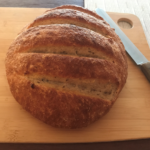Jewish Rye Bread
Servings: 1 round loaf
Print Recipe
Ingredients
Sponge
- ¾ cup (4 oz) bread flour
- ¾ cup (3.3 oz) rye flour
- ½ tsp (0.06 oz) instant yeast
- 1½ Tbsp (0.6 oz) sugar
- ½ Tbsp honey
- 1½ cups water, room temperature
Bread
- 2¼ cups (12.4 oz) bread flour, divided
- ½ tsp plus ⅛ tsp instant yeast
- 2 Tbsp (0.5 oz) caraway seeds
- 1½ tsp (0.3 oz) salt
- 1½ tsp (0.25 oz) vegetable oil
- ½ cup ice cubes
- 2 tsp approx. (0.5 oz) for sprinkling
Instructions
Sponge
- In a large bowl, combine the bread flour, rye flour, yeast, sugar, honey and water.
- Whisk until very smooth, scraping down the sides of the bowl. The sponge will have the consistency of thick batter. Switch to plastic dough scraper if sponge gets too thick for whisk.
- Cover the bowl with plastic wrap and set the sponge aside while you combine the flour mixture.
Bread
- In a large bowl, whisk together 2 cups bread flour (reserve one-fourth cup), the yeast, caraway seeds and salt.
- Remove the plastic wrap from the sponge and gently scoop the flour mixture over the sponge to cover it completely. Cover bowl tightly with plastic wrap and set it aside at room temperature to ferment until the sponge bubbles through the flour mixture in places, 1 to 4 hours. (I find it usually takes about 2 hours.)
- When fermented, add the oil to the bowl and, using a wooden spoon or your hand, stir until the flour is moistened. Knead the dough in the bowl for 5 minutes, enough to develop the gluten structure a little, adding as little of the reserved flour as possible to keep it from sticking. Use a curved bench or dough scraper to scrape the dough and gather it as you knead it in the bowl. At this point, it may be a little sticky.
- Cover the dough with an inverted bowl and set it aside to rest for 20 minutes, then knead the dough until it is very smooth and elastic, an additional 5 to 10 minutes. If the dough is still sticky, knead in a little more flour.
- Place the dough in a 2-quart bowl, lightly greased with oil. Press down on the dough and lightly oil the top. Cover the bowl with plastic wrap. Set the dough aside to rise until doubled in size, 1 1/2 to 2 hours.
- Turn the dough out onto a slightly floured counter (using bread flour) and press it down to flatten it slightly. Form the dough into a ball about 5 1/2 inches wide by 2 1/2 inches high and set it on a cornmeal-sprinkled baking sheet. Cover it with a large container or oiled plastic wrap. Set the dough aside to rise until almost doubled, 1 hour to 1 hour and 15 minutes.
- Have an oven shelf at the lowest level and place a baking stone or baking sheet on it before heating the oven. Place a cast-iron skillet or sheet pan on the floor of the oven to preheat. Preheat the oven to 450° F.
- With a sharp knife or single-edged razor blade, make 4 slashes one-fourth- to one-half-inch deep in the top of the dough. Mist the dough with water and quickly but gently set the baking sheet on the hot stone or hot baking sheet. Toss one-half cup of ice cubes into the pan beneath and immediately shut the door.
- Bake for 8 minutes then, using a heavy spatula, lift the bread from the pan and set it directly on the stone, turning it around as you do for even baking. Continue baking another 7 minutes.
- Lower the temperature to 400° F. and continue to bake until the bread is golden and the loaf reads 190° F. on an instant-read thermometer, I start checking at 5 minutes, but generally takes about 10 minutes to reach 190° F.
- Remove the bread from the oven, and transfer to a wire rack to cool completely.
Notes
Play around with the sweetener. Try barley malt syrup, sugar or even molasses for a change.
Adapted from an article in the LA Times.


Leave a Reply